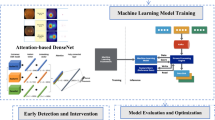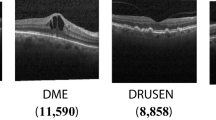Abstract
An optical coherence tomography (OCT) image is becoming the standard imaging modality in diagnosing retinal diseases and the assessment of their progression. However, the manual evaluation of the volumetric scan is time consuming, expensive and the signs of the early disease are easy to miss. In this paper, we mainly present an attention-based deep learning method for the retinal disease classification in OCT images, which can assist the large-scale screening or the diagnosis recommendation for an ophthalmologist. First, according to the unique characteristic of a retinal OCT image, we design a customized pre-processing method to improve image quality. Second, in order to guide the network optimization more effectively, a specially designed attention model, which pays more attention to critical regions containing pathological anomalies, is integrated into a typical deep learning network. We evaluate our proposed method on two data sets, and the results consistently show that it outperforms the state-of-the-art methods. We report an overall four-class accuracy of 97.4%, a two-class sensitivity of 100.0%, and a two-class specificity of 100.0% on a public data set shared by Zhang et al. with 1,000 testing B-scans in four disease classes. Compared to their work, our method improves the numbers by 0.8%, 2.2%, and 2.6% respectively.
Access this chapter
Tax calculation will be finalised at checkout
Purchases are for personal use only
Similar content being viewed by others
Change history
27 December 2019
The original version of this book was revised. Due to a technical error, the first volume editor did not appear in the volumes of the MMM 2020 proceedings. A funding number was missing in the acknowledgement section of the chapter titled “AttenNet: Deep Attention Based Retinal Disease Classification in OCT Images.” Both were corrected.
References
Awais, M., et al.: Classification of SD-OCT images using a deep learning approach. In: IEEE ICSIPA, pp. 489–492 (2017)
Çiçek, Ö., Abdulkadir, A., Lienkamp, S.S., Brox, T., Ronneberger, O.: 3D U-Net: learning dense volumetric segmentation from sparse annotation. In: Ourselin, S., Joskowicz, L., Sabuncu, M.R., Unal, G., Wells, W. (eds.) MICCAI 2016. LNCS, vol. 9901, pp. 424–432. Springer, Cham (2016). https://doi.org/10.1007/978-3-319-46723-8_49
Ciulla, T.A., et al.: Diabetic retinopathy and diabetic macular edema: pathophysiology, screening, and novel therapies. Diabetes Care 26(9), 2653–2664 (2003)
Dai, B., Bu, W., Wang, K., Wu, X.: Fundus lesion detection based on visual attention model. In: Che, W., et al. (eds.) ICYCSEE 2016. CCIS, vol. 623, pp. 384–394. Springer, Singapore (2016). https://doi.org/10.1007/978-981-10-2053-7_34
De Fauw, J., et al.: Clinically applicable deep learning for diagnosis and referral in retinal disease. Nat. Med. 24(9), 1342–1350 (2018)
Drexler, W., et al.: State-of-the-art retinal optical coherence tomography. Progress Retinal Eye Res. 27(1), 45–88 (2008)
Fang, L., et al.: Attention to lesion: lesion-aware convolutional neural network for retinal optical coherence tomography image classification. IEEE Trans. Med. Imaging 38(8), 1959–1970 (2019)
Gulshan, V., et al.: Development and validation of a deep learning algorithm for detection of diabetic retinopathy in retinal fundus photographs. JAMA 316(22), 2402–2410 (2016)
Hassan, T., et al.: Review of OCT and fundus images for detection of macular edema. In: IEEE IST, pp. 1–4 (2015)
He, K., et al.: Deep residual learning for image recognition. In: IEEE CVPR, pp. 770–778 (2016)
Huang, G., et al.: Densely connected convolutional networks. In: IEEE CVPR, pp. 4700–4708 (2017)
Karri, S.P.K., et al.: Transfer learning based classification of optical coherence tomography images with diabetic macular edema and dry age-related macular degeneration. Biomed. Optics Express 8(2), 579–592 (2017)
Kermany, D.S., et al.: Identifying medical diagnoses and treatable diseases by image-based deep learning. Cell 172(5), 1122–1131 (2018)
Lee, C.S., et al.: Deep learning is effective for classifying normal versus age-related macular degeneration oct images. Ophthalmol. Retina 1(4), 322–327 (2017)
Liu, Y.Y., et al.: Automated macular pathology diagnosis in retinal oct images using multi-scale spatial pyramid and local binary patterns in texture and shape encoding. Med. Image Anal. 15(5), 748–759 (2011)
Naz, S., et al.: A practical approach to OCT based classification of diabetic macular edema. In: IEEE ICSigSys, pp. 217–220 (2017)
Perdomo Charry, O., et al.: Classification of diabetes-related retinal diseases using a deep learning approach in optical coherence tomography. Comput. Methods Programs Biomed. 178, 181–189 (2019)
Ravenscroft, D., et al.: Learning feature extractors for AMD classification in OCT using convolutional neural networks. In: IEEE EUSIPCO, pp. 51–55 (2017)
Reif, R., et al.: Motion artifact and background noise suppression on optical microangiography frames using a Naive Bayes mask. Appl. Opt. 53, 4164–4171 (2014)
Srinivasan, P.P., et al.: Fully automated detection of diabetic macular edema and dry age-related macular degeneration from optical coherence tomography images. Biomed. Opt. Express 5(10), 3568–3577 (2014)
Szegedy, C., et al.: Rethinking the inception architecture for computer vision. In: IEEE CVPR, pp. 2818–2826 (2016)
Varadarajan, A.V., et al.: Deep learning for predicting refractive error from retinal fundus images. Invest. Ophthalmol. Vis. Sci. (IOVS) 59, 2861–2868 (2018)
Venhuizen, F.G., et al.: Automated age-related macular degeneration classification in OCT using unsupervised feature learning. In: Medical Imaging, vol. 9414 (2015)
Wang, F., et al.: Residual attention network for image classification. In: IEEE CVPR, pp. 3156–3164 (2017)
Acknowledgement
This work is supported by the CSC State Scholarship Fund (201806295014), NSFC (No. 61672523), CAMS Initiative for Innovative Medicine (2018-I2M-AI-001), Beijing NSF (No.4192029, No.7184236), National Key Research & Development Plan (No.2017YFC0108200), and NSF of Guangdong Province (No.2017A030313649).
Author information
Authors and Affiliations
Corresponding authors
Editor information
Editors and Affiliations
Rights and permissions
Copyright information
© 2020 Springer Nature Switzerland AG
About this paper
Cite this paper
Wu, J. et al. (2020). AttenNet: Deep Attention Based Retinal Disease Classification in OCT Images. In: Ro, Y., et al. MultiMedia Modeling. MMM 2020. Lecture Notes in Computer Science(), vol 11962. Springer, Cham. https://doi.org/10.1007/978-3-030-37734-2_46
Download citation
DOI: https://doi.org/10.1007/978-3-030-37734-2_46
Published:
Publisher Name: Springer, Cham
Print ISBN: 978-3-030-37733-5
Online ISBN: 978-3-030-37734-2
eBook Packages: Computer ScienceComputer Science (R0)




